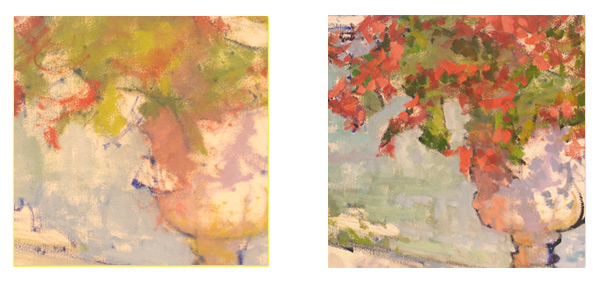Complete In Any Stage: Go For The Rush, Forget The Gold Star
I decided to return to this theme largely because of the “readers reaction.” They had assumed that I was asking the question, “How do you know when a painting is finished?” I wasn’t. I was suggesting that the concept of “finished,” as it is normally used to describe the point at which a manufactured product comes to completion, is inappropriate in describing a painting, at least the kind that I do. Let me, then, spell out what I mean by “complete.”

In the image above, you will find two internal squares identified with the letter “A.” As you may have anticipated, both of these “A” squares have the same value. They are identical. However, the square surrounded by a light area seems darker and vice versa. Hence, an area with one value is influenced by the value of what’s around it. So if someone says that the mountain is dark, implicitly one is suggesting a relationship: darker than what? Values are always relationships.¹
Colors are relationships, too. Take a look at the image below. Again, the squares marked “A” are identical and yet they appear to be different in color. A color acquires its appearance in relationship to what surrounds it. So once again, one must squint and compare in order to assess the proper color (relationship).

So here’s the technical requirement that I’m getting at: at each moment of the process a painting ought to have correct value and color relationships. It ought to be complete at any stage. The image below captures two moments in the painting process of a particular painting. As it first emerges out of a white canvas (image on the left), the darks may be relatively light (high key). Further along (image on right) but still an hour or more before I stopped, I have dropped the value of the darks down a little more but then I drop the values of the middles down a little, too: the relationship between darks and middles is fixed (always!). The same is true for color; if I develop the reds more richly, so must I develop the greens, grays, and other colors so that color relationships remain constant (even if now the painting is in a lower key). The painting is always a whole, always complete, regardless of where I choose to stop.

Suggesting that the concept “finished” is a category mistake when it comes to painting is not a semantics issue. It goes to the art of how we approach painting and what it is that we are doing as we are painting. I am suggesting that we ought to think of a painting (and making art generally) less as a manufactured product and more of something alive that grows and moves in unexpected directions, not unlike jazz improvisation or even like the growth of a child.
Little Johnny is complete at 5 years old as much as he is at fifteen. It would be strange, too, if by 7 years old, one of Johnny’s legs was that of a 12-year old and one of his arms was that of a 9-year old, but magically he comes together, parts perfectly related, at 15. Then it might make sense to say that little Johnny was finished. But this would also mean that his life was over.
Picasso believed the same could be said for painting: “To be finished means to be through with it, to kill it, to rid it of its soul, to give it its final blow, the most unfortunate one for the painter as well as for the painting.” Always complete. Always alive – the painter and painting as one.
The Payoff
So why go about making paintings complete at any stage, as opposed to coming together at some end point called “finished?” Because then I can totally ignore the end point and the great evaluation of the product that goes along with it as the payoff: is it good or bad? Which, in turn, means that I am good or bad. Instead, I am set free to enjoy every blessed moment of the creative process, not really sure as to where I will go with it. I don’t look for results. I open to “the rush.” This means that I will be more intensely alive as I paint and so will be my painting. I don’t have to think about the painting. All I do is open to the next prompt: oh those “darks” are so velvety. There seems to be hints of viridians in among the alizarin and ultramarine blue. Oh! And that dark blue seems to have some warm in it, cad yellow medium perhaps? And off I go, caught up in a visual dance of sorts, feeling larger, more capable, more confident. Certainly better than if I focused throughout on the result: gee, it doesn’t look like water. Dear me, I have a ways to go before it’s finished!
How agonizing is that? It’s like taking a freaking exam. I’m always having to measure up, to produce a product that gets a good grade from someone else. This is the result of absorbing, unreflectively, the values of a culture organized around production, productivity, efficiency, market shares, performance measures, and hierarchies within hierarchies. I try to let that go, all of it. I need to find me. Never enough time.
Go for the rush. Forget the gold star. The payoff is in the moment of creation.
¹A common example of when values are incorrect is when someone makes mountains too dark because against a light sky, they look very dark; but compared to something dark in the foreground, the mountains may actually be light. We are able to get a better understanding of values when we squint and compare. This enables us to see the whole and within the whole we can see what is the darkest element (by comparison), the next darkest and so on.
2 Comments
Address
Via Teresio Olivelli, 20
22021 Bellagio (CO)
Italy
+39 338 975 7135
Open Hours
Tuesday - Saturday: 11:00am – 6:00pm
Sunday - Monday: 1:00pm – 6:00pm

Hi Jerry. You may not remember me – I was in the Gang of Three from Ireland two summers ago. I was very new to oil painting but have stuck with it with varying degrees of failure/success! In the last few months I have completely shifted focus and decided to just – paint. No exhibitions, no framing, no showing – and what a difference it has made. I so totally ‘get’ what you have written about ignoring the end product and being set free to enjoy the experience. For me – it’s not what I’m painting anymore – it’s how I’m painting it. I’m going to print out your article and pin it up in my studio to remind me. Thanks for that gentle ‘kick’ Judy
Hi Judy – yes I remember the Gang of Three; what a delightful comment! Thank you. Jerry